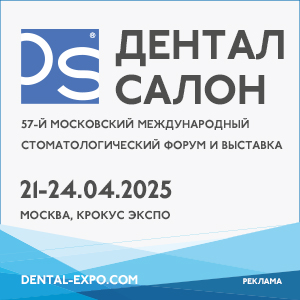DOI:
10.37988/1811-153X_2024_2_112Full arch rehabilitation of patients with severe atrophy of the upper jaw using the transnasal technique of implants placement
Downloads
Abstract
Aim — to evaluate the results of treatment of patients with severe atrophy of the upper jaw (class VI atrophy according to the Cawood & Howell classification) using transnasal technique of implants placement in the immediate and long-term postoperative periods.Materials and methods.
We observed 21 patients who were aged from 53 to 84 years with severe atrophy of the bone tissue of the alveolar process of the upper jaw to the basal level. The main causes of bone tissue deficiency in the upper jaw were: peri-implantitis (n=3); periapical leassures (n=10); long-term adentia and expereance of removable dentures (n=8). The method of 4—6 implants placement was chosen as a method of rehabilitation of patients, including two transnasal, two zygomatic and in some cases two pterygoid implants with immediate loading using temporary acrylic prosthesis reinforced with a titanium bar.
Results.
All patients show a positive effect of complex treatment using the transnasal technique of implant placement. We did not observe a single complication associated with the transnasal technique that resulted in loss or removal of the implant. All patients were rehabilitated and had positive treatment dynamics, including a long-term follow-up period from 12 to 36 months.
Conclusion.
The analysis of the treatment of patients with severe atrophy of the edentulous upper jaw using the transnasal dental implantation technique allows us to speak about its effectiveness and recommend it as a method of choice and as an alternative to the technique for four zygomatic implants placement. However, it is worth noting that this technique requires further long-term observation of patients due to the small accumulated world experience and the few publications on this topic. It would be interesting to conduct comparative studies of long-term treatment results using the technique of four zygomatic implants placement and a hybrid protocol for two zygomatic and two transnasal implants placement.
Key words:
zygoma, quad zygoma, transnasal implants, Vanderlim technique, severe atrophy of upper jawFor Citation
[1]
Trokhalin A.V., Camargo V.B., Bulgakova A.I., Uchadze G.I. Full arch rehabilitation of patients with severe atrophy of the upper jaw using the transnasal technique of implants placement. Clinical Dentistry (Russia). 2024; 27 (2): 112—120. DOI: 10.37988/1811-153X_2024_2_112
References
- Almeida P.H.T., Cacciacane S.H., Arcazas Junior A. Extra-long transnasal implants as alternative for Quad Zygoma: Case report. Ann Med Surg (Lond). 2021; 68: 102635. PMID: 34386227
- Almeida P.H.T., Salvoni A.D., França F.M.G. Evaluation of satisfaction of individuals rehabilitated with zygomatic implants as regards anesthetic and sedative procedure: A prospective cohort study. Ann Med Surg (Lond). 2017; 22: 22—29. PMID: 28924474
- Khyshov V.B., Khyshov M.V., Samsonov V.V., Sharshin M.A. The use of zygomatic implants for dental rehabilitation of patients with atrophy of the upper jaw. Hospital Medicine: Science and Practice. 2019; 1: 53—55 (In Russian). eLIBRARY ID: 41725242
- Almeida P.H.T., Cacciacane S.H., França F.M.G. Stresses generated by two zygomatic implant placement techniques associated with conventional inclined anterior implants. Ann Med Surg (Lond). 2018; 30: 22—27. PMID: 29946455
- Davó R., David L. Quad zygoma: Technique and realities. Oral Maxillofac Surg Clin North Am. 2019; 31 (2): 285—297. PMID: 30947849
- Selsky N.E., Shcherbakov D.A., Korotik I.O., Trokhalin A.V. Zygomatic implantation. Complications. In: Shcherbakov D.A., Popov I.B., Polev G.A., Krotova A.S., Cheremnykh N.I. (ed.) Dental maxillary sinusitis: a practical guide for doctors. Salekhard: Pechatnik, 2019. Pp. 71—76 (In Russian).
- Sokirko E.L., Lenskaia P.A., Goldshtein E.V., Suchkov D.S., Absava K.A., Kolchanov G.M. Surgical complications in zygomatic implants and ways of their prevention. The Dental Institute. 2018; 2 (79): 73—75 (In Russian). eLIBRARY ID: 35340576
- Davo R., Pons O., Rojas J., Carpio E. Immediate function of four zygomatic implants: a 1-year report of a prospective study. Eur J Oral Implantol. 2010; 3 (4): 323—34. PMID: 21180685
- Van Camp P., Vrielinck L., Gemels B., Politis C. Intraorbital hemorrhage following a secondary intervention at integrated zygomatic implants: A case report. Int J Surg Case Rep. 2018; 43: 21—24. PMID: 29414502
- Camargo V.B., Baptista D., Manfro R. Implante transnasal (técnica Vanderlim) como opção ao segundo implante Zigomático. In: Coppedê A. (ed.) Soluções clínicas para reabilitações totais sobre implantes sem enxertos ósseos. São Paulo: Quintessence, 2019. Pp. 198—214 (In Portuguese).
- Aparicio C., Manresa C., Francisco K., Claros P., Alández J., González-Martín O., Albrektsson T. Zygomatic implants: indications, techniques and outcomes, and the zygomatic success code. Periodontol 2000. 2014; 66 (1): 41—58. PMID: 25123760
- Aparicio C., Antonio S. Zygoma anatomy-guided approach «Scarf graft» for prevention of soft tissue dehiscence around zygomatic implants: Technical note. Int J Oral Maxillofac Implants. 2020; 35 (2): e21—e26. PMID: 32142581
- Cawood J.I., Howell R.A. A classification of the edentulous jaws. Int J Oral Maxillofac Surg. 1988; 17 (4): 232—6. PMID: 3139793
- Camargo V.B., Baptista D., Grossi J.R.A. [Transnasal implants: the Vanderlim technique as an alternative to the Quad Zygoma technique in completely atrophic maxillae: a 12-case series report under immediate loading and 2-to-26-month follow-up]. Implant News. 2021; 6 (5): 674—83 (In Portuguese).
- Guerrero C.A. Five zygomaticus implants to treat severe maxillary atrophy. International Journal of Oral and Maxillofacial Surgery. 2009; 38 (5): 505—506. DOI: 10.1016/j.ijom.2009.03.391
- Guerrero C.A. Sáder G., Henríquez M., Trujillo R., Pisano R., Sabogal A., Mont’Alverne A. Pentagonal design zygoma fixtures anchorage for immediate maxillary rehabilitation. ImplantNews. 2012; 9 (6a-PBA): 49—55. http://kstom.ru/cg4955
Downloads
Received
October 14, 2023
Accepted
May 29, 2024
Published on
June 28, 2024











